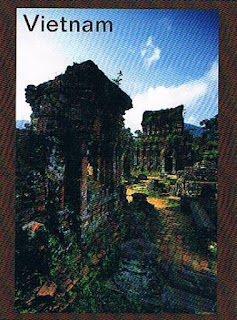My Son Sanctuary
The Champa Kingdom was an important phenomenon in the political and cultural history of South-East Asia, vividly illustrated by the ruins of My Son. The sanctuary is an exceptional example of cultural interchange, with the introduction of the Hindu architecture of the Indian subcontinent into South-East Asia.
My Son, a valley surrounded by mountains, was chosen as the site for a religious centre for the capital of the Champa Kingdom. The sanctuary area is one of the most famous Champa architectural and sculptural monuments in Viet Nam.
The Champa Kingdom began in AD 192. The Cham economy was based on farming (wet-rice agriculture), fishing, and seaborne trade. When the Cham came under the influence of the Hindu religion many temples were built to the Hindu divinities, such as Krishna and Vishnu, but above all Shiva. Mahayana Buddhism must have penetrated the Cham culture later, probably in the 4th century, and became strongly established in the north of the Champa Kingdom.
While the religious significance of My Son was important, its location in a small valley surrounded by high mountains gave it strategic significance as an easily defensible stronghold. Successive kings in the 6th to 8th centuries favoured My Son and endowed it with fine temples. In the later 10th century, most of the finest surviving architectural monuments were built there.
Most of the 11th century was a period of continuous warfare and My Son, along with other sacred sites in the Champa Kingdom, suffered grievously. Harivarman IV had moved his capital to Do Ban towards the end of the century and he undertook the restoration of My Son. From 1190 to 1220 the Champa Kingdom was occupied by the Khmers. From the 13th century the Champa Kingdom slowly declined and was absorbed by the growing power of Viet Nam. It ceased to exist as an entity in the later 15th century, when worship ceased at My Son.
The site represents the ancient settlement and sanctuary area; eight groups of tower temples have been singled out. In date they cover the period from the 10th to the 13th centuries, and this long date range is reflected in different architectural styles. All are constructed in fired brick with stone pillars and decorated with sandstone bas-reliefs depicting scenes from Hindu mythology.
The main tower (kalan ) symbolizes the sacred mountain (meru ) at the centre of the universe. The square or rectangular base (bhurloka ), representing the human world, is built from brick or stone blocks and decorated with reliefs. Above this rises the main tower (bhuvakola ), constructed entirely in brick, with applied columns and a false door facing east.
The interiors are plain, with small niches for lamps; the Shivalingam was situated on a plinth in the centre. It symbolized the spirit world. The towers were separated from their roofs (suarloka ) by a decorated frieze. Many of these roofs were originally covered with gold or silver leaf.
The predominant style of the architecture and sculptural decoration of the My Son temples derives directly from India.
Source: UNESCO/CLT/WHC


No comments:
Post a Comment